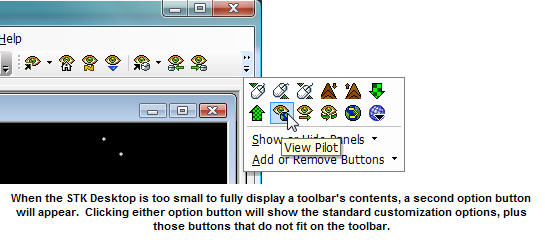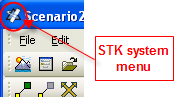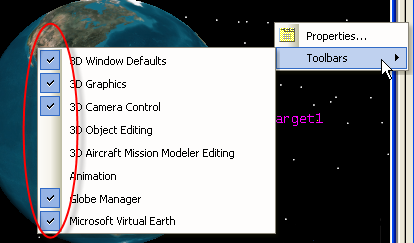Using STK Toolbars
STK toolbar system is designed for usability, flexibility, and easy customization. Toolbars specific to a particular window are located on that window giving you quick access to features relevant to the window. For more information on what you can do with toolbars, see
- Quick and easy customization
- Automatic resizing of toolbars
- STK Window Toolbar Placement and Customization
- Options for Hiding/Displaying Toolbars
You can also customize toolbars by selecting Toolbars from the View menu. For more information, see Customizing Toolbars.
Customize Quickly
Clicking a toolbar's Options button gives you quick access to customization features.

Automatic Resizing of Toolbars
If you size any window that is part of the STK workspace so that one (or more) of its toolbars would be too large to fit in that window, the toolbar(s) automatically resize, hiding buttons as needed. These buttons can still be accessed via the Options button.

Customize STK Window Toolbars
Toolbars exist on several STK windows, allowing quick access to those features relevant to the window. So, whether you have the windows integrated, docked, or floating, the toolbars associated with the window always travel with it.
These toolbars are independent of the main application's toolbars in most respects, and independent of other windows having the same toolbars. So which toolbars are showing on which windows is completely customizable, as are the individual buttons on those toolbars, without affecting the toolbars on the main application or other windows.
For example, if you do most of your work in a 3D Graphics window, you can float that window and utilize its toolbars directly, and reduce the size of the rest of the STK workspace.

- If you drag a toolbar to redock it to another side of a window, it will only dock to the window that created it. If you float multiple toolbars with the same title, for example multiple "3D Graphics" toolbars, it may become difficult to remember which window is the "owner" of that toolbar.
- If you customized toolbars in STK prior to version 9, these customized toolbars are incompatible with the new system and will not be loaded.
Whenever a new 3D Graphics or 2D Graphics window is created it will have the toolbar layout of the same type of window in the default scenario. You can change this layout and save it as the default toolbar by right-clicking the toolbar and selecting Save Toolbar Layout as Default from the pop-up menu. Then when you open subsequent graphics windows they will have the new default toolbar layout.
Hiding and Displaying Toolbars
Choose one of the following ways to hide or display a toolbar in an STK window: right-click in the window and highlight Toolbars, right-click the toolbar, or click the window’s system menu, as shown in the example below.

A checkmark indicates that the toolbar is currently being displayed in the window, as shown in the example below. To hide a toolbar or display a hidden toolbar, click it.

 Visit AGI.com
Visit AGI.com